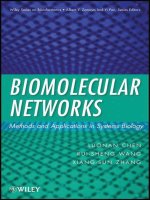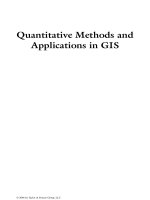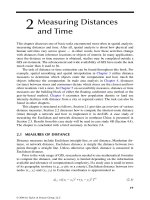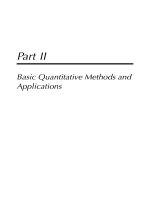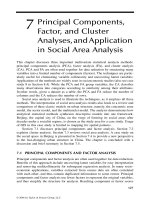biomolecular networks methods and applications in systems biology
Bạn đang xem bản rút gọn của tài liệu. Xem và tải ngay bản đầy đủ của tài liệu tại đây (5.64 MB, 420 trang )
BIOMOLECULAR
NETWORKS
BIOMOLECULAR
NETWORKS
Methods and Applications in
Systems Biology
LUONAN CHEN
Osaka Sangyo University, Japan
RUI-SHENG WANG
Renmin University of China, China
XIANG-SUN ZHANG
Chinese Academy of Science, China
Copyright # 2009 by John Wiley & Sons, Inc. All rights reserved
Published by John Wiley & Sons, Inc., Hoboken, New Jersey
Published simultaneously in Canada
No part of this publication may be reproduced, stored in a retrieval system, or transmitted in any form or
by any means, electronic, mechanical, photocopying, recording, scanning, or otherwise, except as permitted
under Section 107 or 108 of the 1976 United States Copyright Act, without either the prior written
permission of the Publisher, or authorization through payment of the appropriate per-copy fee to the
Copyright Clearance Center, Inc., 222 Rosewood Drive, Danvers, MA 01923, (978) 750-8400, fax (978)
750-4470, or on the web at www.copyright.com. Requests to the Publisher for permission should be
addressed to the Permissions Department, John Wiley & Sons, Inc., 111 River Street, Hoboken, NJ 07030,
(201) 748-6011, fax (201) 748-6008, or online at />Limit of Liability/Disclaimer of Warranty: While the publisher and author have used their best efforts in
preparing this book, they make no representations or warranties with respect to the accuracy or completeness
of the contents of this book and specifically disclaim any implied warranties of merchantability or fitness
for a particular purpose. No warranty may be created or extended by sales representatives or written sales
materials. The advice and strategies contained herein may not be suitable for your situation. You should
consult with a professional where appropriate. Neither the publisher nor author shall be liable for any loss
of profit or any other commercial damages, including but not limited to special, incidental, consequential,
or other damages.
For general information on our other products and services or for technical support, please contact our
Customer Care Department within the United States at (800) 762-2974, outside the United States at
(317) 572-3993 or fax (317) 572-4002.
Wiley also publishes its books in variety of electronic formats. Some content that appears in print may
not be available in electronic formats. For more information about Wiley products, visit our web site at
www.wiley.com.
Library of Congress Cataloging-in-Publication Data:
Chen, Luonan, 1962Biomolecular networks : methods and applications in systems biology / Luonan Chen, Rui-Sheng Wang,
Xiang-Sun Zhang.
p. cm.
Includes bibliographical references and index.
ISBN 978-0-470-24373-2 (cloth)
1. Molecular biology– Data processing. 2. Computational
biology. 3. Bioinformatics. 4. Biological systems– Research–Data processing
I. Wang, Rui-Sheng. II. Zhang, Xiang-Sun, 1943- III. Title.
QH506.C48 2009
572.80285—dc22
2009005776
Printed in the United States of America
10 9
8 7
6 5
4 3 2
1
We Dedicate This Book to Our Colleagues and Our Families
CONTENTS
PREFACE
xiii
ACKNOWLEDGMENTS
xv
LIST OF ILLUSTRATIONS
xvii
ACRONYMS
xxiii
1 Introduction
1.1
1
Basic Concepts in Molecular Biology / 1
1.1.1 Genomes, Genes, and DNA Replication Process / 5
1.1.2 Transcription Process for RNA Synthesis / 6
1.1.3 Translation Process for Protein Synthesis / 7
1.2 Biomolecular Networks in Cells / 8
1.3 Network Systems Biology / 13
1.4 About This Book / 18
I GENE NETWORKS
23
2 Transcription Regulation: Networks and Models
25
2.1
Transcription Regulation and Gene Expression / 25
2.1.1 Transcription and Gene Regulation / 25
2.1.2 Microarray Experiments and Databases / 28
2.1.3 ChIP-Chip Technology and Transcription Factor
Databases / 30
2.2
2.3
2.4
2.5
Networks in Transcription Regulation / 32
Nonlinear Models Based on Biochemical Reactions / 36
Integrated Models for Regulatory Networks / 43
Summary / 44
vii
viii
CONTENTS
3 Reconstruction of Gene Regulatory Networks
3.1
Mathematical Models of Gene Regulatory
Network / 47
3.1.1
3.1.2
3.1.3
3.1.4
3.2
47
Boolean Networks / 48
Bayesian Networks / 49
Markov Networks / 52
Differential Equations / 53
Reconstructing Gene Regulatory Networks / 55
3.2.1 Singular Value Decomposition / 56
3.2.2 Model-Based Optimization / 58
3.3
Inferring Gene Networks from Multiple Datasets / 61
3.3.1 General Solutions and a Particular Solution of Network
Structures for Multiple Datasets / 63
3.3.2 Decomposition Algorithm / 65
3.3.3 Numerical Validation / 67
3.4
Gene Network-Based Drug Target Identification / 72
3.4.1 Network Identification Methods / 73
3.4.2 Linear Programming Framework / 77
3.5
Summary / 87
4 Inference of Transcriptional Regulatory Networks
4.1 Predicting TF Binding Sites and Promoters / 89
4.2 Inference of Transcriptional Interactions / 92
4.2.1 Differential Equation Methods / 93
4.2.2 Bayesian Approaches / 96
4.2.3 Data Mining and Other Methods / 98
4.3
4.4
Identifying Combinatorial Regulations of TFs / 99
Inferring Cooperative Regulatory Networks / 105
4.4.1
4.4.2
4.4.3
4.4.4
4.5
Mathematical Models / 105
Estimating TF Activity / 106
Linear Programming Models / 108
Numerical Validation / 109
Prediction of Transcription Factor Activity / 114
4.5.1 Matrix Factorization / 114
4.5.2 Nonlinear Models / 117
4.6
Summary / 118
89
CONTENTS
II PROTEIN INTERACTION NETWORKS
5 Prediction of Protein– Protein Interactions
5.1
5.2
ix
119
121
Experimental Protein – Protein Interactions / 121
Prediction of Protein– Protein Interactions / 126
5.2.1 Association Methods / 127
5.2.2 Maximum-Likelihood Estimation / 134
5.2.3 Deterministic Optimization Approaches / 139
5.3
Protein Interaction Prediction Based on Multidomain Pairs / 150
5.3.1 Cooperative Domains, Strongly Cooperative Domains,
Superdomains / 152
5.3.2 Inference of Multidomain Interactions / 154
5.3.3 Numerical Validation / 157
5.3.4 Reconstructing Complexes by Multidomain
Interactions / 160
5.4
Domain Interaction Prediction Methods / 163
5.4.1
5.4.2
5.4.3
5.4.4
5.5
Statistical Method / 163
Domain Pair Exclusion Analysis / 163
Parsimony Explanation Approaches / 164
Integrative Approaches / 165
Summary / 167
6 Topological Structure of Biomolecular Networks
6.1
6.2
6.3
Statistical Properties of Biomolecular Networks / 169
Evolution of Protein Interaction Networks / 173
Hubs, Motifs, and Modularity in Biomolecular
Networks / 174
6.3.1 Network Centralities and Hubs / 174
6.3.2 Network Modularity and Motifs / 177
6.4
Explorative Roles of Hubs and Network Motifs / 179
6.4.1 Dynamic Modularity Organized by Hubs
and Network Motifs / 180
6.4.2 Network Motifs Acting as Connectors
between Pathways / 186
6.5
Modularity Evaluation of Biomolecular Networks / 194
6.5.1 Modularity Density D / 195
6.5.2 Improving Module Resolution Limits by D / 196
169
x
CONTENTS
6.5.3 Equivalence between D and Kernel k Means / 198
6.5.4 Extension of D to General Criteria: Dl and Dw / 199
6.5.5 Numerical Validation / 200
6.6
Summary / 204
7 Alignment of Biomolecular Networks
7.1
7.2
205
Biomolecular Networks from Multiple Species / 205
Pairwise Alignment of Biomolecular Networks / 207
7.2.1 Score-Based Algorithms / 208
7.2.2 Evolution-Guided Method / 211
7.2.3 Graph Matching Algorithm / 212
7.3
Network Alignment by Mathematical Programming / 213
7.3.1 Integer Programming Formulation / 214
7.3.2 Components of the Integer Quadratic Programming
Approach / 216
7.3.3 Numerical Validation / 217
7.4 Multiple Alignment of Biomolecular Networks / 223
7.5 Subnetwork and Pathway Querying / 225
7.6 Summary / 228
8 Network-Based Prediction of Protein Function
8.1
8.2
Protein Function and Annotation / 231
Protein Functional Module Detection / 234
8.2.1 Distance-Based Clustering Methods / 235
8.2.2 Graph Clustering Methods / 236
8.2.3 Validation of Module Detection / 238
8.3
Functional Linkage for Protein Function Annotation / 239
8.3.1
8.3.2
8.3.3
8.3.4
8.4
Bayesian Approach / 239
Hopfield Network Method / 241
p-Value Method / 242
Statistical Framework / 243
Protein Function Prediction from High-Throughput Data / 249
8.4.1
8.4.2
8.4.3
8.4.4
Neighborhood Approaches / 250
Optimization Methods / 251
Probabilistic Methods / 254
Machine Learning Techniques / 256
231
CONTENTS
8.5
Function Annotation Methods for Domains / 265
8.5.1
8.5.2
8.5.3
8.5.4
8.6
Domain Sources / 267
Integration of Heterogeneous Data / 268
Domain Function Prediction / 270
Numerical Validation / 271
Summary / 277
III METABOLIC NETWORKS AND SIGNALING
NETWORKS
9
Metabolic Networks: Analysis, Reconstruction,
and Application
9.1
9.2
Flux Balance Analysis / 286
Elementary Mode and Extreme Pathway Analysis / 288
Modeling Metabolic Networks / 292
Pathfinding Based on Reactions and Compounds / 294
Stoichiometric Approaches Based on Flux Profiles / 297
Inferring Biochemical Networks from
Timecourse Data / 298
Drug Target Detection in Metabolic Networks / 300
9.4.1
9.4.2
9.4.3
9.5
Drug Target Detection Problem / 301
Integer Linear Programming Model / 302
Numerical Validation / 305
Summary / 311
10 Signaling Networks: Modeling and Inference
10.1
10.2
Signal Transduction in Cellular Systems / 313
Modeling of Signal Transduction Pathways / 316
10.2.1
10.2.2
10.3
281
Reconstruction of Metabolic Networks / 294
9.3.1
9.3.2
9.3.3
9.4
279
Cellular Metabolism and Metabolic Pathways / 281
Metabolic Network Analysis and Modeling / 286
9.2.1
9.2.2
9.2.3
9.3
xi
Differential Equation Models / 317
Petri Net Models / 319
Inferring Signaling Networks from
High-Throughput Data / 321
10.3.1
NetSearch Method / 322
313
xii
CONTENTS
10.3.2
10.3.3
10.4
Inferring Signaling Networks by Linear Programming / 326
10.4.1
10.4.2
10.4.3
10.4.4
10.5
10.6
Ordering Signaling Components / 323
Color-Coding Methods / 324
Integer Linear Programming Model / 327
Significance Measures / 329
Numerical Validation / 329
Inferring Signaling Networks by Network
Flow Models / 338
Inferring Signaling Networks from Experimental Evidence / 341
Summary / 343
11 Other Topics and New Trends
11.1
11.2
11.3
11.4
11.5
345
Network-Based Protein Structural Analysis / 345
Integration of Biomolecular Networks / 347
Posttranscriptional Regulation of Noncoding RNAs / 349
Biomolecular Interactions and Human Diseases / 350
Summary / 352
REFERENCES
353
INDEX
381
PREFACE
Network-based systems biology (or Network Systems Biology), an emerging area
focusing on various biomolecular networks, is a multidisciplinary intersection of
mathematics, computer science, and biology. Burgeoning high-throughput data are
driving the integrative study from describing complex phenomena to understanding
essential design principles, from studying individual components to understanding
functional networks for biomolecular systems, cells, organs, and even entire organisms. To elucidate the fundamental mechanisms of cellular systems, study of biomolecular networks is increasingly attracting much attention from many academic fields
such as mathematics, information science, and the life sciences. A major challenge in
network systems biology is to investigate how cellular systems facilitate biological
functions by various interactions (pathways and networks) between genes, proteins,
and metabolites. Based on analytical and computational methodologies, network systems biology studies how an organism, viewed as a dynamical or interacting network
of biomolecules (e.g., genes, proteins, and complexes) and biochemical reactions,
eventually gives rise to a complex life. In contrast to individual molecules, biomolecular networks governed by universal laws offer a new conceptual framework that
could potentially revolutionize our view of biology and pathology. Therefore, it is
mandatory that mathematicians and computer scientists provide theoretical and
computational methodologies to reveal the essential biological mechanisms of
living organisms from a system or network perspective.
Keeping this in mind, this book comprehensively covers the contents and the topics
on modeling, inferring, and analyzing biomolecular networks in cellular systems on
the basis of available experimental data, in particular stressing the aspects of network,
system, integration, and engineering. Each topic is treated in depth with specific biological problems and novel computational methods. From a biological viewpoint, this
book, based on the authors’ research work and experience in studying biomolecular
networks, describes a variety of research topics related to biomolecular networks
with deep analysis of many real examples and detailed descriptions of the latest
trends, such as gene regulatory networks, transcription regulatory networks, protein
interaction networks, metabolic networks, signal transduction networks, and integration of heterogenous networks. On the other hand, from a computational perspective, this book covers many theoretical or computational methods from several areas,
such as optimization, differential equations, probability theory, statistics, graph theory,
complex systems, network analysis, statistical thermodynamics, graphical modeling,
and machine learning, which are all applied in the analysis of biomolecular networks.
xiii
xiv
PREFACE
The goal of this book is to help readers understand the state-of-the-art techniques
in bioinformatics and systems biology, particularly the theory and application of
biomolecular networks.
The potential readers are (1) specialists and advanced students in systems biology
and computational biology and practitioners in industry, (2) researchers and graduate
students in computer science and mathematics who are interested in systems biology,
and (3) molecular biologists who are interested in using computational tools to analyze
biological networks. Hence, any university or research institute with a bioinformatics
or systems biology program in this field will find this book useful.
The contents of this book are based mainly on collaborative studies and discussions with many researchers, including Drs. Yong Wang (Chapters 3, 8), Dong Xu
(Chapter 3), Ling-Yun Wu (Chapter 5), Zhenping Li (Chapters 6, 7, 9), Shihua
Zhang (Chapters 6, 7), Guangxu Jin (Chapter 7), Xing-Ming Zhao (Chapters 8,
10), and Zhi-Ping Liu (Chapter 11). Collectively and individually, we express our
gratitude to these people for their collaboration.
LUONAN CHEN
RUI-SHENG WANG
XIANG-SUN ZHANG
October 2008
ACKNOWLEDGMENTS
To those colleagues who contributed the materials for this book and shared their
expertise and vision, the authors express their sincerest gratitude and appreciation.
In particular, the authors thank Prof. Dong Xu in University of Missouri,
Columbia, Drs. Yong Wang, Ling-Yun Wu, Shihua Zhang, Guangxu Jin in
Academy of Mathematics and Systems Science, CAS, Prof. Zhenping Li in Beijing
Wuzi University, and Drs. Xing-Ming Zhao, Ruiqi Wang, Achyut Sapkota, Prof.
Zengrong Liu in Shanghai University, Dr. Zhi-Ping Liu in Osaka Sangyo
University for their cooperation in bringing this book to completion.
LUONAN CHEN
RUI-SHENG WANG
XIANG-SUN ZHANG
xv
LIST OF ILLUSTRATIONS
Figures
1.1.
1.2.
1.3.
1.4.
1.5.
1.6.
1.7.
1.8.
1.9.
1.10.
1.11.
2.1.
2.2.
2.3.
2.4.
2.5.
2.6.
2.7.
2.8.
2.9.
3.1.
3.2.
3.3.
3.4.
3.5.
3.6.
The Double-Helix DNA Backbone with Complementary Base Pairs
The Double-Helix Structure of a DNA
The Central “Dogma” of Molecular Biology
The Structure of Eukaryotic Genes and Splicing Process
The Mapping Rules (Genetic Codes) from Codons to Amino Acids
The Structure of tRNA
Ingredients in Cellular Systems in Terms of Network Architecture
Omic Data and Biomolecular Networks
Systems Biology Focusing on Integrating Omic Data
The Research Focus of Network Systems Biology
Biomolecular Networks with Major Computational Tools Applied in This Book
Gene Structure and Transcription Process
The Whole Process of Gene Expression
Scheme of the cDNA Microarray Technique
Scheme of the ChIP-Chip Experiment Process
Genetic Interactions in Gene Regulatory Networks
Illustrations of a Single Node Input-Output Device and a Gene Regulatory
Network
Structural Organization of Transcription Regulatory Networks
Illustrations of a TF Binding to DNA and Starting Transcription
Scheme of a Node in a Nonlinear Gene Regulatory Network
A Boolean Network for Three Genes
An Example of a Simple Bayesian Network
Graphical View of a Dynamic Bayesian Network Model
A Simple Example of a Markov Network
Number of Errors E as Function of Number of Measurements for Four Linear
Networks
Critical Number of Measurements Required to Recover the Entire Connectivity
Matrix Correctly versus Network Size for Linear Systems
xvii
xviii
3.7.
3.8.
3.9.
3.10.
3.11.
3.12.
3.13.
3.14.
3.15.
4.1.
4.2.
4.3.
4.4.
4.5.
4.6.
4.7.
4.8.
4.9.
4.10.
4.11.
5.1.
5.2.
5.3.
5.4.
5.5.
5.6.
5.7.
5.8.
LIST OF ILLUSTRATIONS
The Scheme of GRNInfer for Inferring Gene Regulatory Networks
A Simulated Example with l ¼ 0 and without Noise
A Simulated Example with Noise
Two Connected Subnetworks of the 64-Link Inferred Yeast Cell Cycle
Regulatory Network
The Inferred 35-Link Arabidopsis thaliana Stress Response Regulatory Network
Schematic Overview of the Mode-of-Action by Network Identification (MNI)
Method
Scheme of the Linear Programming (LP) Framework
Results of the LP Approach on the Simulated Network
Results for SOS Network
Scheme for Inferring TRN from Various Kinds of Transcription Data
Reconstructing Transcriptional Regulatory Networks by Integrating DNA
Sequence and Gene Expression Information
Combinatorial Control in Gene Regulation
Expression Profiles of Genes Containing the Motifs Mcm1 and/or SFF
An Illustrative Example of a Thermodynamic Model for One TF with Two
Binding Sites
Illustration of a Transcription Complex Participating in a Transcription Process
Yeast Cell Cycle Transcriptional Regulatory Network
Comparison Results of LP Method Based on TCs, LP Method Based on mRNA
Levels of TFs, and SVD Method Based on mRNA Levels of TFs
Transcription Regulatory Network for Polyphosphate Metabolism
Workflow for Inferring Regulator Activity Profiles from Gene Expression Data
and ChIP-chip Data
ICA, PCA, and NCA for a Regulatory System in Which the Output Data Are
Driven by Regulatory Signals through a Bipartite Network
Overview of a Yeast Two-Hybrid Assay System
Mapping Protein – Protein Interactions Using Mass Spectrometry
Schematic Representation for Inferring Protein – Protein Interactions from
Domain Information
An Illustrative Example of Two Proteins with Four Domains
Comparison of Various Methods for Specificity and Sensitivity on YIP Training
Data and Testing Data
Comparison of Various Methods for Specificity and Sensitivity on YIP Test
Data with Varying Reliability
ROC Curves of Prediction Results Based on Multiple Organism (Three
Organisms) Data and Single Organism Data, Respectively
Comparison of Distributions of Pearson Correlation Coefficients for Top 1000
Predicted Interacting Protein Pairs Based on Multiple Organism Data and
Single Organism Data, Respectively
LIST OF ILLUSTRATIONS
xix
5.9. Numbers of Matched Protein Pairs to MIPS1 among All Predictions by the
Parsimony Model (PM) and MLE
5.10. An Illustrative Example of Multidomain Interactions
5.11. Cooperative Domains in the Complex Crystal Structure Formed by Proteins
P02994 and P32471
5.12. Comparison of RMSE on Two-Domain Pairs and Multidomain Pairs for
Krogan’s Yeast Extended Datasets
5.13. Comparison of Three Methods for Domain Interaction Prediction
5.14. Reconstruction of DNA-Directed RNA Polymerase Complex
6.1. Illustrations of a Random Network and a Scale-Free Network
6.2. Date Hubs and Party Hubs in Protein Interaction Networks
6.3. Motifs and Modules in Protein Interaction Networks
6.4. Proportions of mPHs and mDHs within the Hubs Common in FYI and
HC fyi
6.5. Spatial Distribution of mDHs and mPHs
6.6. Cellular Localizations of mDHs and mPHs
6.7. Effects of Deleting mPHs with Their Motifs and mDHs with Their Motifs
6.8. The Filtered Human Interactome (FHI) Network and Motif Clusters in FHI
6.9. p Values of Motif Clusters Located between Cancers and Other Signal
Pathways
6.10. p Values for Motif Clusters Located between Type II Diabetes Mellitus and
Other Signal Pathways
6.11. Schematic Examples of (a) a Clique Circle Network and (b) a Network with
Two Pairs of Identical Cliques
6.12. Comparison of Several Methods on Computer-Generated Networks with
Known Community Structure
6.13. Karate Club Network and Optimal Partition Detected by Modularity Density D
6.14. Journal Index Network and the value of D versus Different Partitions
7.1. A Scheme of Biomolecular Network Alignment
7.2. Illustration of Pairwise Pathway Alignment and Merged Alignment Graph
7.3. A Tutorial Network Alignment Example from PathBLAST Plugin of Cytoscape
Software with l ¼ 0.5 by MNAligner
7.4. A Simulated Alignment Example of Two Directed Networks with l ¼ 0.5 by
MNAligner
7.5. Illustration of Well-Matched Subnetworks in Yeast and Fly Protein Interaction
Networks with l ¼ 0.9
7.6. Three Matched Interspecies Metabolic Pathway Pairs with l ¼ 0.9
7.7. Two Matched Intra-species Pairs with l ¼ 0.9
7.8. Illustration of a Scheme for Multiple Network Alignment
7.9. Biomolecular Network Querying Examples for Multiple Species and
Conditions
xx
LIST OF ILLUSTRATIONS
7.10. Overview of Biomolecular Network Querying from Perspective of Systems
Biology
8.1. Distribution of Score Sij for Gavin’s Core Dataset
8.2. Correlation Analysis of Z score with GO Similarity
8.3. A Functional Module in Constructed Functional Linkage Network Revealed by
Statistical Framework
8.4. Illustration of Protein Function Prediction Based on Protein Interaction Data and
Other Data Sources
8.5. Comparison of Five Methods for Function Prediction
8.6. Sensitivity versus 12Specificity for Threshold-Based Classification Method on
InterPro Domains
8.7. Comparison of Threshold-Based Classification Method, SVM, and Logistic
Regression for InterPro Domains
8.8. Sensitivity versus 12Specificity for Threshold-Based Classification Method on
Pfam-A Domains
8.9. Comparison of SVM Method, Threshold-Based Classification Method, and
Logistic Regression on Pfam-A Domains
8.10. Results Obtained by Logistic Regression Model with Various Combinations of
Information Sources for Pfam-A Domains
9.1. Major Components of the Cellular Metabolism
9.2. Overview of the Main Metabolic Pathways
9.3. Illustration of a Reaction Network and Flux Balance Analysis
9.4. Elementary Modes and Extreme Pathways in a Reaction Network
9.5. Petri Net Modeling of Different Basic Reactions: Synthesis, Decomposition,
Catalysis, Inhibition, and Reversible Reaction
9.6. Flowchart of Reconstruction of a Genome-Scale Metabolic Network
9.7. An Illustrative Metabolic Network
9.8. Graphical Illustration of the Integer Linear Programming Model
9.9. Comparison of LP and ILP on Various Metabolic Pathways in Terms of
Implementing CPU Time and Average Damage
9.10. Comparison of LP and ILP on E. coli Entire Metabolic Network in Terms of
Implementing CPU Time and Average Damage
9.11. Fraction of Essential Enzymes Plotted against Enzymes with Certain Damage
10.1. Coarse-Grained View of Signal Transduction
10.2. Example of a Petri Net
10.3. An Enzyme-Catalyzed Reaction Formulated Using Various Models
10.4. The MAPK Signaling Pathways for Yeast
10.5. Pheromone Response Signaling Pathways and Networks
10.6. Signaling Pathways of Filamentous Growth
10.7. Yeast MAPK Signaling Networks Detected by ILP Model from Integrated Data
LIST OF ILLUSTRATIONS
xxi
Tables
2.1.
2.2.
3.1.
3.2.
4.1.
4.2.
4.3.
4.4.
4.5.
4.6.
5.1.
5.2.
5.3.
5.4.
5.5.
5.6.
5.7.
5.8.
6.1.
6.2.
6.3.
6.4.
7.1.
8.1.
8.2.
8.3.
8.4.
8.5.
8.6.
8.7.
8.8.
Some Microarray Databases and Their Websites
Some Experimental and Predicted Transcription Factor Databases
Accuracies in Terms of Different Error Criteria and Confidence Evaluation
The SOS Network and Predicted Perturbations for E. coli
Several Databases of TF Binding Sites
Some Software for Searching TF Binding Sites
Databases of Promoters and TSSs
TFs Related to Yeast Cell Cycle and Their Transcription Complexes
p Values of Periodicity for Some TFs Related to Cell Cycle
TFs Related to Polyphosphate Metabolism and Their Transcription Complexes
Some Databases of Protein –Protein Interactions
Major Databases of Domain– Domain Interactions
Comparison of Various Methods for RMSE and Training Time on
YIP Data
Comparison of Various Methods for Average RMSE and Training Time on
THY Data
Performance of Various Methods in Terms of Correlation Coefficient on YIP
Results of Permutation Tests on Protein Interaction Data from Three Species
Number of Matched Domain Interactions with iPfam
Numbers of Matched Protein Pairs to MIPS1 among All Predictions
Statistical Significance of Differences between SAMCs of mDHs and mPHs
p Values for Pathogenesis Pathways with Respect to Cancers
Performance Comparison of Three Community Detection Methods on
Symmetric and Asymmetric Networks
Performance Comparison of Three Community Detection Methods for Model
Selection
Software Tools for Network Alignment or Pathway Querying
Gene and Protein Function Annotation Databases
Selected Functional Categories and Numbers of Annotated Genes
Results of Tenfold Cross-Validation Using Five Methods Averaged over 13
Classes
Prediction Results Using Five Methods Averaged over 13 Classes
Selected GO Terms for InterPro Domains
Selected GO Terms for Pfam-A Domains
Tenfold Cross-Validation Results Averaged over 20 Classes by ThresholdBased Classification Method on InterPro Domains
Tenfold Cross-Validation Results Averaged over 20 Classes by SVMs on
InterPro Domains
xxii
LIST OF ILLUSTRATIONS
8.9. Tenfold Cross-Validation Results Averaged over 10 Classes by ThresholdBased Classification Method on Pfam-A Domains
8.10. Tenfold Cross-Validation Results Averaged over 10 Classes by SVMs on
Pfam-A Domains
8.11. Top Five Domains Assigned to Each GO Function Class with Highest
Probabilities
9.1. Six Major Classes of Enzymes According to Enzyme Commission
9.2. Some Databases of Metabolic Pathways
9.3. List of Drug Targets for Some Drugs Detected by ILP Approach with Validation
(Vd) Status
10.1. List of Signal Transduction Databases
10.2. Comparison of Different Methods for Detecting Pheromone Pathways on the
Basis of Protein Interaction Data
10.3. Comparison of Different Methods for Detecting Filamentation Pathway on the
Basis of Protein Interaction Data
10.4. Protein Interaction Data and Gene Expression Data for Detecting Yeast MAPK
Pathways
10.5. p Values of Functional Enrichment for Pheromone Response Signaling
Network Found by ILP
10.6. Performance of ILP Model in Detecting MAPK Signaling Networks
ACRONYMS
2DE
AGPS
AMC
ANOVA
APM
APMM
ASNM
BIND
BOLS
BTR
CAGE
CATH
CBB
CBM
CD
CDD
ChIP
COG
CPM
DBN
DDI
DDIB
DIP
DP
DPEA
EBI
EC
EGF
EM
ERF
ERK
FA
FBA
GAP
GEF
Two-dimensional gel electrophoresis
Annotating genes with positive samples
Average motif correlation
Analysis of variance
Association probabilistic method
Association probabilistic method with multidomain pairs
Association numerical method
Biomolecular Interaction Network Database
Bayesian orthogonal least squares
Binary transitive reduction
Cap analysis of gene expression
Class, Architecture, Topology, and Homologous superfamily database
Coomassie Brilliant Blue
Conserved Binding Mode database
Czekanowski-Dice (distance)
Conserved Domain Database
Chromatin immunoprotein
Cluster(s) of orthologous groups
Clique percolation method
Dynamical Bayesian network
Domain –domain interaction
Database of domain interactions and bindings
Database of Interacting Proteins
Dynamic programming
Domain pair exclusion analysis
European Bioinformatics Institute
Enzyme Commission
Epidermal growth factor
Expectation maximization
Ethylene response factor
Extracellular signal-regulated kinase
Factor analysis
Flux balance analysis
GTPase-activating protein
Guanine exchange factor
xxiii


